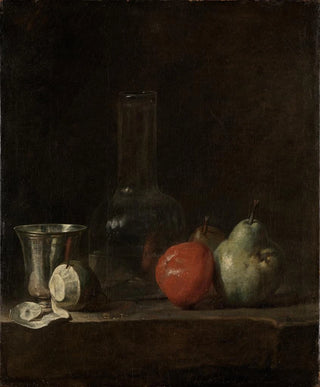Art print | Still life with glass bottle and fruits - Jean Siméon Chardin


View from behind

Frame (optional)
In the fascinating world of painting, few works manage to capture the essence of simplicity with as much brilliance as the "Art print with glass bottle and fruits" by Jean Siméon Chardin. This iconic piece, created in the 18th century, immerses us in a world where every detail, every shade of color, tells a story. Chardin, an undisputed master of the genre, succeeds in transforming everyday objects into true witnesses of beauty and refinement. The composition, both harmonious and delicate, invites the viewer to a deep contemplation, revealing the subtleties of light and textures. Approaching this art print, one almost feels the freshness of the fruits and the transparency of the glass, as if transported into the artist's workshop.
Style and uniqueness of the work
Chardin stands out with his unique approach to the art print, blending realism and poetry. In this piece, the glass bottle, with its dazzling transparency, captures light in an almost magical way, creating reflections that dance across the surface. The fruits, carefully arranged, seem to vibrate with life, their vibrant colors contrasting with the sobriety of the background. The artist skillfully plays with shadows and lights, giving each element an almost tactile dimension. What makes this art print particularly singular is the way Chardin manages to breathe soul into inanimate objects. One cannot help but contemplate the relationship between the bottle and the fruits, a subtle interaction that evokes themes of life, mortality, and ephemerality. Each glance at this work reveals new nuances, unsuspected details, testifying to Chardin's creative genius.
The artist and his influence
Jean Siméon Chardin, a major figure of the 18th century, established himself as a pioneer of the art print in art history. His style, imbued with realism, stands out from the conventions of his time, where baroque and rococo predominated. Chardin, by choosing to depict scenes of daily life, paved the way

Matte finish

View from behind

Frame (optional)
In the fascinating world of painting, few works manage to capture the essence of simplicity with as much brilliance as the "Art print with glass bottle and fruits" by Jean Siméon Chardin. This iconic piece, created in the 18th century, immerses us in a world where every detail, every shade of color, tells a story. Chardin, an undisputed master of the genre, succeeds in transforming everyday objects into true witnesses of beauty and refinement. The composition, both harmonious and delicate, invites the viewer to a deep contemplation, revealing the subtleties of light and textures. Approaching this art print, one almost feels the freshness of the fruits and the transparency of the glass, as if transported into the artist's workshop.
Style and uniqueness of the work
Chardin stands out with his unique approach to the art print, blending realism and poetry. In this piece, the glass bottle, with its dazzling transparency, captures light in an almost magical way, creating reflections that dance across the surface. The fruits, carefully arranged, seem to vibrate with life, their vibrant colors contrasting with the sobriety of the background. The artist skillfully plays with shadows and lights, giving each element an almost tactile dimension. What makes this art print particularly singular is the way Chardin manages to breathe soul into inanimate objects. One cannot help but contemplate the relationship between the bottle and the fruits, a subtle interaction that evokes themes of life, mortality, and ephemerality. Each glance at this work reveals new nuances, unsuspected details, testifying to Chardin's creative genius.
The artist and his influence
Jean Siméon Chardin, a major figure of the 18th century, established himself as a pioneer of the art print in art history. His style, imbued with realism, stands out from the conventions of his time, where baroque and rococo predominated. Chardin, by choosing to depict scenes of daily life, paved the way






